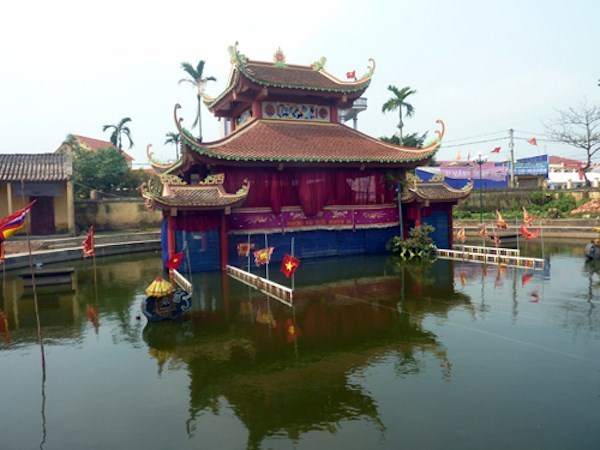
Vietnam has announced eight additional national intangible cultural heritages under the Decision No.3325/DD-BVHTTDL, recently signed by Minister of Culture, Sports, and Tourism Nguyen Ngoc Thien.

A venue for water puppetry (Source: VNA)
They include papermaking by the Dao Do ethnic people in Viet Quang
town, Bac Quang district, the northern province of Ha Giang; Dum singing in the
communes of Phuc Le, Pha Le, Lap Le, Tam Hung, and Ngu Lao in Thuy Nguyen
district, the northern city of Hai Phong; Qua Son temple festival in Boi Son
commune, of Do Luong district, the central province of Nghe An; as well as Lang
Son temple festival in Trung Nghia commune, Thanh Thuy district, the northern
province of Phu Tho.
Others consist of the coming of age worship ritual by the Ede ethnic group in
Song Hinh commune, in Son Hoa district, the central province of Phu Yen; Linh
Son Thanh Mau (Mother Goddess of the Mountain) festival in the southern
province of Tay Ninh; water puppetry in Nguyen Xa and Dong Cac communes, in
Dong Hung district, the northern province of Thai Binh; as well as the
traditional bronze casting of Che village in Thieu Trung commune,in Thieu Hoa
district, the central province of Thanh Hoa.
Under the decision, the chairpersons of People’s Committees of localities,
where the new national intangible cultural heritages were recognised, were
required to manage them well in line with the law.
As of September 2018, Vietnam boasted nearly 260 national intangible cultural
heritages.
Source: VNA
The People’s Committee of Lac Son district held a ceremony on April 28 to receive the provincial relic certificate for the ancient rock carving site at Suoi Co stream, located in My Thanh commune.
A special music show titled "The country is in the fullness of joy” has been held at Hoa Binh Square in Hoa Binh city in celebration of the 50th anniversary of the liberation of the South and national reunification (April 30, 1975–2025).
The People's Committee of Lo Son commune, Tan Lac district, has organised the local annual traditional stream fishing festival on April 19 - 20.
As a land deeply intertwined with human history and Vietnam’s millennia-long journey of nation-building and defence, Hoa Binh is often revered for its epic tales and legends.
Residents of Hoa Binh boast a rich cultural identity, reflected in their unique language, traditional attire, customs, and folk melodies – described as "sweet as honey, clear as a mountain stream.”
Lac Son district’s Vu ban town held the 2025 Truong Kha temple festival on April 12–13 (the 15th–16th days of the third lunar month). Since its revival in 2019, the festival has been organised every three years, preserving valuable intangible heritage while meeting the community’s cultural and spiritual needs.



